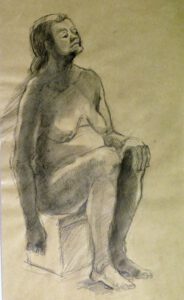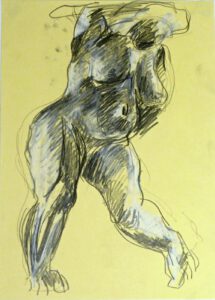Drawing courses – not only according to the live model
To look around us with quite different eyes than we are normally used to

Something about me
I have been engaged in drawing from a live model for many years. I myself studied drawing with our leading artists, such as painter and sculptor Vojtěch Adamec Jr. and Vojtěch Adamec Sr., Josef Hnízdil, ak. sculp. Peter Oriešek, Jan Stoss, M.A., prof. ak. sculp. Boris Jirků.
After completing my studies at the Academy of Fine Arts, I founded the Lesnická Studio in Smíchov. Here I then taught modeling and drawing portraits and nudes from a live model.
For eight years I led students at the Architectural Institute in Prague (ARCHIP). An international university focused on foreign students. We worked on architectural models in clay and other materials, where students modeled and drew a portrait from a live model. I also taught Art Preparation at the Art Econ secondary art school in Kobylisy.
Portrait from a live model
Thanks to a live model, we can create not only a technically well-constructed portrait from a drawing, but also allow us to express the unique personality and atmosphere of our model. I want to offer my students both the opportunity to master the basics of drawing and to use this drawing input to convey a new perspective on the world around us and within ourselves.
What will the course bring you?
You will learn to look at the world with very different eyes than you are used to. You will adopt the approach of transferring what you observe onto paper so that your drawing has volume and a plastic effect. You will learn to think plastically, that is, you will learn to work with perspective. You will develop a skill that is creative and thus your personality will develop in a new direction. You will relax because you will only be concerned with yourself. It will be time for you.
Portrait based on a live model

Thanks to a live model, we can create not only a technically well-constructed portrait from a drawing, but also allow us to express the unique personality and atmosphere of our model. I want to offer my students the opportunity to master the basics of drawing, and to use this drawing input to convey a new perspective on the world around us and within ourselves.
- At the beginning of the drawing work, we will focus on the structure of the head. We will learn to measure the structure of the head in relation to the neck and shoulders. We will learn to lay out the drawing well on paper and use the total area of the paper so that the drawing is neither too large nor too small, but fits comfortably into the format and looks natural.
- An important point will be the basics of muscle anatomy and the entire musculoskeletal system. It will be practical to imagine the movement of muscles, how they work in our own body. And then we will try to project the idea into a drawing. The basics of geometry and the relationships between masses will also help us.
- Next, we will focus on the model’s posture, which will show us how the human body works, where the tension of the muscles contrasts with the stillness of the masses. We will see how each portrait is unique, and we will learn how much this uniqueness needs to be respected when working.
- We will tune in to our model, to its atmosphere, what is characteristic and natural for it, and how not to lose this atmosphere even when completing the work.
- We will learn to observe the model and our own drawing from greater distances, or even from different angles, so that we can see the overall impression, which will be key to our drawing.
- We will focus not only on the personality of our model, but also on our own personality and uniqueness. We will look for our own style. Perceiving what is our own and typical for us. This can then result in what exactly we want to express and in what way. I think it is important for every student to realize that their handwriting is already there, and they just need to get to it and let it manifest. For this, they need time and space for themselves and their work. Drawing takes time and it takes time for a person to get where they need to be.
- During the lessons, we will work on the same model with our fellow students. Comparing ourselves will allow us to get an idea of where we are with our drawing skills, what we can do, and what we are struggling with. At the same time, we will see where we can move forward, and thus we can learn from our colleagues. Comparing ourselves with our colleagues is irreplaceable and healthy.
- Together we will talk about what we see in the works of our colleagues, what suits them in their drawings and what doesn’t. We will learn to form our own opinion on what we subjectively like and what we don’t. We will learn to clearly express and describe the feelings that the works of other classmates evoke in us. We will practice accepting positive and negative feedback, which we will learn to process constructively – these are skills that will greatly advance us in drawing, they are just as important as the drawing itself.
 In conclusion, I would like to say that I consider drawing from a live model, whether it is a still life, portrait, or nude, to be one of the most beautiful art disciplines, which is worth studying at least briefly in life. To look around us with quite different eyes than we are usually used to.
In conclusion, I would like to say that I consider drawing from a live model, whether it is a still life, portrait, or nude, to be one of the most beautiful art disciplines, which is worth studying at least briefly in life. To look around us with quite different eyes than we are usually used to.
Course dates
April 26th – 27th, 2025 at the Art Studio in Balbínova Street in Prague
- Balbínova 28, Praha 2 – Vinohrady
- E-mail: info@malovanikresleni.cz
- Phone: +420 777 422 022 (v provozu od 8 do 18 hod v pracovních dnech)
- Course price 2 800 Kč
- More information https://www.malovanikresleni.cz
18. – 19. 10. 2025 and 11. – 12. 4. 2026 in the Keramika guesthouse in Děbolín near Jindřichův Hradec
-
- Penzion Keramika Děbolín 26, 377 01 Jindřichův Hradec
- E-mail: info@penzionkeramika.cz
- Phone: +420 602 476 331
- Course price 5 000Kč
- More information https://www.penzionkeramika.cz/